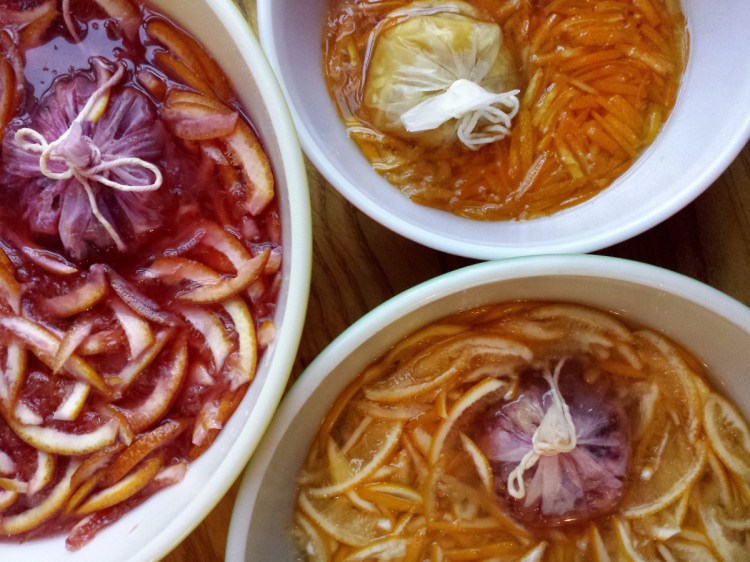My friend Zora Margolis was born and bred in citrus-rich California, grew up in kitchens on both coasts to be a skilled, generous cook, and annually makes an excellent marmalade laced with single malt Scotch whisky. Who better to turn to than Margolis, who now lives in Edgecomb, for advice on how to pull off greenest, peel-heavy, confiture I possibly can?
Given that citrus doesn’t generally grow on trees in Maine, we’re starting with trucked-in fruit. When spending those kind of food miles, the sustainable thing to do use every last bit of orange, lemon, lime, grapefruit and kumquat that comes my way. Making marmalade involves the peel, pith, pulp and pips.
Margolis has experimented with marmalade made from thin-skinned Meyer lemons (a cross between lemons and tangerines) and citron (aka Buddha hands, which look like lemons with fingerlike extensions) to pretty Cara Cara oranges and vibrant blood ones. She shuns sweeter juicing and navel oranges because the marmalade-making process requires a lot of sugar to set the end product, so you want to start with tart fruit. She favors Spanish Seville oranges, sometimes called bitter oranges, because her husband is a traditionalist.
As the story goes, and is retold by Andrew Webb in “Food Britannia,” the Scotch brought marmalade to the breakfast table circa 1779 when Dundee resident James Keiller bought a job lot of bitter Seville oranges from a Spanish ship docked there. He’d not realized when he bought them that these oranges were too bitter to eat out of hand. To save the investment, Keiller’s “enterprising wife got busy with a knife and some sugar, and Dundee marmalade was born,” Webb says. It is still made today by MacKay’s, a jam maker in Arbroath, located just a couple miles up the coast from Dundee.

Christine Burns Rudalevige’s kumquat marmalade. The spoon, with its Scottish thistle, was given to Rudalevige by her husband’s British grandmother.
Last year, Margolis special-ordered Seville oranges from Rising Tide Community Market in Damariscotta. She took 10 pounds, and the co-op sold the remainder in its citrus display. She points out that most of the commercial citrus fruit available this far north – whether grown organically or conventionally – is coated with food-grade wax, which is applied to prolong shelf life. Margolis dips each piece of citrus in boiling water and rubs off the wax with a dry towel. Food preservation blogger and cookbook author Marissa McClellen simply washes her citrus in warm, soapy water.
Armed with a bowlful of all the variations of citrus I could find in Hannaford, I liberally employed McClellan’s basic formula for making marmalade in small batches in “Preserving by the Pint: Quick seasonal canning for small spaces.”
Take 1 pound of any citrus fruit. Wash and dry it. Top and tail each piece of fruit. Stand each up on its end and cut it into six wedges. Lay each wedge on its side and cut away the strip of inner membrane and seeds. Slice each trimmed wedge very thinly (each strip should be 1/8 inch thick).Place the membranes and seeds on a piece of cheese cloth that you’ll tie up later and use as a pectin bundle to thicken the marmalade. Place the sliced peel and pulp, 2 cups of water, 2 cups of sugar (MacKay’s recommends raw cane sugar, which is less processed than refined white sugar) and the tied bundle of membranes into a large, non-reactive pan.

Lemons chopped for Meyer lemon and lavender marmalade.
McClellan recommends covering the pan and letting the mixture macerate overnight. Margolis likes to simmer it for a few minutes so that the peels sit in a melded syrup overnight.
After the waiting period, both marmalade makers bring their mixtures to a boil and simmer them until they are quite thick, which takes 15-30 minutes, depending on the size of your batch. The marmalade will set well once it hits a temperature of 220 degrees F.
They also encourage cooks to tart up their marmalade with interesting ingredients. For example, McClellan suggests putting a tablespoon of lavender buds in the pectin sack when using Meyer lemons. Margolis is planning on fiddling with a Thai concoction that includes limes, lemongrass and ginger. And then there’s the matter of her signature addition: Scotch whisky. Always add that after you’ve removed the pot from the flame to both avoid a fire in your kitchen and keep the kick in your marmalade.
CHRISTINE BURNS RUDALEVIGE is a food writer, recipe developer and tester and cooking teacher in Brunswick, and the author of “Green Plate Special,” a cookbook from Islandport based on these columns. She can be contacted at cburns1227@gmail.com.
Send questions/comments to the editors.


